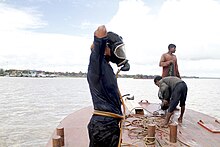
Yangon, formerly romanized as Rangoon, is the capital of the Yangon Region and the largest city of Myanmar. Yangon served as the capital of Myanmar until 2006, when the military government relocated the administrative functions to the purpose-built capital city of Naypyidaw in north central Myanmar. With over five million people, Yangon is Myanmar's most populous city and its most important commercial centre.

Magway Region is an administrative division in central Myanmar. It is the second largest of Myanmar's seven divisions, with an area of 44,820 km2. Pa Del Dam (ပဒဲဆည်) is one of the dams in Aunglan Township, Magway Division. The capital and second largest city of the Magway Division is Magway. The largest city is Pakokku. The major cities of Magway Division are Magway, Pakokku, Aunglan, Yenangyaung, Taungdwingyi, Chauk, Minbu, Thayet and Gangaw.

Bago, formerly known as Hanthawaddy, is a city and the capital of the Bago Region in Myanmar. It is located 91 kilometres (57 mi) north-east of Yangon.
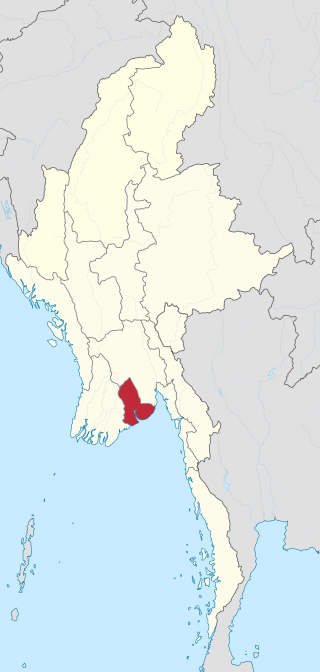
Yangon Region is an administrative region of Myanmar. Located in central Myanmar, the region is bordered by Bago Region to the north and east, the Gulf of Martaban to the south, and Ayeyarwady Region to the west. Yangon Region is dominated by its capital city of Yangon, the former national capital and the largest city in the country. Other important cities are Thanlyin and Twante. The division is the most developed region of the country and the main international gateway. The division measures 10,170 km2 (3,930 sq mi).
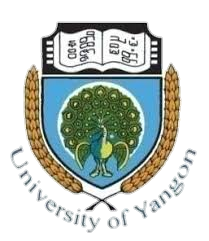
The University of Yangon, located in Kamayut, Yangon, is the oldest university in Myanmar's modern education system and the best known university in Myanmar. The university offers mainly undergraduate and postgraduate degrees programs in liberal arts, sciences and law. Full-time bachelor's degrees were not offered at the university's main campus after the student protests of 1996. The bachelor's degree was re-offered from 2014 on. Today degrees in Political Science are offered to undergraduate students, as well as postgraduate diplomas in areas such as social work and geology.

The Strand is a Victorian-style hotel located in Yangon, Myanmar (Burma), built by Aviet and Tigran Sarkie, two of the Sarkies Brothers. The hotel, which opened in 1901, which faces the Yangon River to its south, is one of the most famous hotels in Yangon and Southeast Asia, and is managed by GCP Hospitality. The hotel is named after its address, at 92 Strand Road.

Basic Education High School No. 2 Dagon is a public high school located a few miles north of downtown Yangon, Myanmar. The former nationalist high school founded for the children of the common folk, now educates mostly the children of well-to-do Burmese families from Dagon and vicinity. It was one of the first "nationalist schools" opened after the First National Strike against the British rule in Burma.
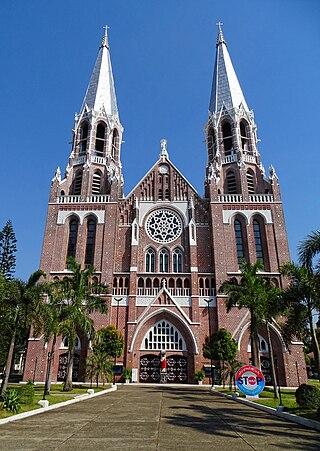
The Archdiocese of Yangon is a Latin Church ecclesiastical territory or diocese of the Catholic Church in Myanmar. Charles Bo, SDB was appointed Archbishop of Yangon by Pope John Paul II on May 24, 2003.

Insein Prison is located in Yangon Division, near Yangon (Rangoon), the old capital of Myanmar. From 1988 to 2011 it was run by the military junta of Myanmar, named the State Law and Order Restoration Council from 1988 to 2003 and the State Peace and Development Council (SPDC) from 2003 to 2011, and was used largely to repress political dissidents.

Myaungmya Township is a township of Myaungmya District in the Ayeyarwady Region of Myanmar. The principal town is Myaungmya.

The history of Jews in Myanmar,, begins primarily in the mid-19th century, when hundreds of Jews immigrated from Iraq during the British colonial period. Cochin Jews came from India and both groups were part of the development of the British Empire, becoming allied with the British in Burma. At its height in 1940 the community of Jews in the country stood at 2,500 members.

Basic Education High School (BEHS) No. 6 Botataung, located a few miles east of downtown Yangon in Botataung township, is a public high school, and one of the oldest high schools in Myanmar. The school initially offered three kindergarten classes - Lower, Middle, Higher known as LKG, MKG, HKG and First through Tenth Standard. It now offers classes from kindergarten to Tenth Standard.
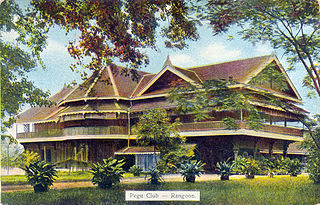
Pegu Club is a recognized heritage site in Yangon, Myanmar, which was a Victorian-style Gentlemen's club founded in 1871 during the British colonization of Burma. The building was built in 1880 and finished in 1882. Pegu Club used to be a place for British officials to spend their time for a drink or two. It was well known because of its signature Pegu Club Cocktail. In southeast Asia, Pegu Club was an equivalent place to the Royal Selangor Club of Kuala Lumpur and The Tanglin Club of Singapore. Rudyard Kipling, as a young newspaperman, visited Pegu Club when he was in Yangon in 1889. Paul Theroux visited Pegu Club in the early 1970s and wrote about it in his book The Great Railway Bazaar. The first phase of the Pegu Club's restoration was completed in 2018.
Rangoon, or Yangon, is the former capital city of Myanmar.
The Gymkhana Ground was a cricket ground in Rangoon, Burma, where a first-class cricket match took place between the touring Marylebone Cricket Club (MCC) and Rangoon Gymkhana.
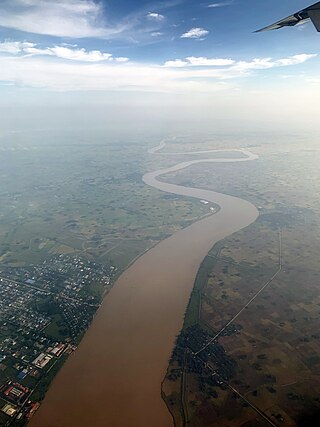
Pazundaung Creek is a stream that empties into Yangon River. The center of Rangoon was established at the confluence of Yangon River to the west and south and Pazundaung Creek to the east. The areas surrounding Pazundaung Creek have high concentrations of Burmese Indians. The Great Bell of Dhammazedi, one of the largest bells in the world, sank into the creek in 1608, when Filipe de Brito e Nicote, then governor of Syriam, removed it from the Shwedagon Pagoda.
The Yangon Japanese School (YJS), previously the Rangoon Japanese School, is a Japanese international school in Dagon Township, Yangon, Burma. It is affiliated with the Embassy of Japan in Myanmar.

The Singu Min Bell, also known as the Maha Gandha Bell, is a large bell located at the Shwedagon Pagoda in Yangon, Myanmar (Burma). It was donated in 1779 by King Singu, the fourth king of Konbaung Dynasty. The official Pali name of the bell is Maha Gandha, which means "Great Sound".

Gandhi Hall, also known as Mahatma Gandhi Memorial Trust, is a building in downtown Yangon, Myanmar, on the Merchant Street corner of Bo Aung Kyaw Road. It was first used as the office of The Rangoon Times, one of the English-language newspapers in British Burma. Later, in 1951, it was bought by Prime Minister U Nu and Indian ambassador M. A. Rauf for the Mahatma Gandhi Memorial Trust. The building is also part of the political history of Myanmar, as it was used for a gathering of elected representatives of the 1990 Myanmar election, who issued the Gandhi Hall Declaration in July 1990.
Thayettaw is a complex of over 60 Buddhist monasteries (kyaung) in Yangon, Myanmar, located in Lanmadaw Township's 9th ward, immediately north of Yangon Chinatown. The monastery occupies a sprawling plot that is bounded by Bogyoke Aung San Road to the north, Anawrahta Road to the south, Phongyi Street to the west, and Myoma School Street to the west.

